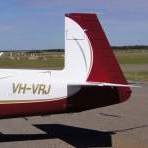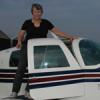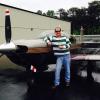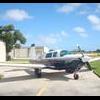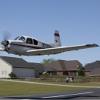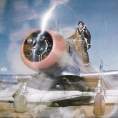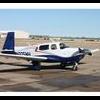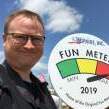Leaderboard
Popular Content
Showing content with the highest reputation on 09/15/2019 in all areas
-
and why I dont set foot in a plane I am not named insured addnl pilot with a waiver of subrogation. I have no desire to allow an insurance carrier to hedge their insurance bet with my assets. Yes, I also carry a non owned policy for instructing, but have found things go smoothly when all the lawyers are on the same side of the table. A lot of people fear their liability is limited if tey do this, but it is only limited to what their policy limits are. Parker Woodruff will expound on this at the Mooney Summit during a roundtable on airport day, Friday Sept 27th at KECP. All are welcome to come, be educated and eat BBQ on Kelly Aerospace and Sheltair.6 points
-
The pilot is PIC, even on a PP checkride, but not being PIC doesn’t always mean the examiner or CFI is completely absolved. A CFI may or may not be PIC with a student, depends on qualifications, medical, and what they’re doing. The owners insurance pays either way... just depends on if they try to subrogate to the CFI. That’s why there’s instructor insurance.6 points
-
Transport category twin turboprops have a system called 'Takeoff Inhibit' that inhibits any failure that triggers an amber 'Master Caution' warning. It is activated from commencement of the takeoff roll until airborne and gear up selection to prevent crew distraction for failures that are considered not critical during the takeoff phase. The crew will not even be aware of the issue until after takeoff. The red 'Master Warning' event (emergency) device is not inhibited so a rejected takeoff can be accomplished, provided the IAS is less than V1 (commit to fly/takeoff speed). This is performance based to prevent runway overruns with serious consequences. Relating this concept to flying my Mooney out of my home airfield runway that is ~ 3,000 feet long: Upon commencement of the takeoff roll I look at the following - IAS alive, power achieved, all instruments in the green then eyes outside. I use the 50/70 rule (that I learnt on this forum) whereby I'll reject the takeoff before the halfway point if an event warrants a rejection, otherwise after this point I'll continue with the takeoff. This is my personal choice and in no way is meant to be critical toward the pilot involved in this accident.4 points
-
Yeah, I got the download to work with another (16GB!) drive I had on-hand. I did re-format it because I'd previously used it to install a Linux distribution (which means it wasn't set up the "standard" way). Needless to say, that drive is now the JPI download drive and will be used for nothing else. Side note: The drive that wouldn't work is a USB3 drive. The one that does is USB2. JPI specifically calls out USB2 in the documentation, so I wonder if the EDM 900 just gets confused when presented with USB3... It wouldn't be the first time I've seen supposedly backwards-compatible hardware fail to work with downlevel clients. (For anyone not aware, USB3+ connectors are all supposed to have blue inserts inside to differentiate them from USB2 and below, which are usually white).3 points
-
Hi, Dan, You might want to add a Mooney20S to your list. I was in the market to replace the beloved 20K that broke. Kissed a lot of flying frogs, as it were. Then I met this charming Screaming Eagle, and fell in love at first sight. Oh, that WOT roar of power, that astonishing climb rate! It occurred to me that living at FL0.0, I really didn’t need the turbo very often, anyway. So, long-body story short,, I bought it as grandmama’s 70th birthday present to herself, learned to appreciate its relative simplicity, stability, interior space, useful load,and capability. Speed? Yep, it’ll do that, but I’m usually content at 9 gph and 168 kts LOP.. Some previous owners with exquisite taste had already upgraded the interior, panel, engine rating and prop, so all I had to do was fly! It has whisked us all over the country so far, from coastal Carolina to Oregon and Calif, over Rockies and all. The instrument rating has been a huge blessing, as thick smoke from widespread western wildfires was as much a non-issue as our east coast low thin overcasts and bumpy cu are. It’s so nice, smooth and cool on top. Of course I have a wish list, but FIKI really isn’t on it. I promised my Creator solemnly years ago I’d never ever get myself in ice again... twice. Fortunately, these are extraordinary airplanes. Enjoy your shopping.3 points
-
With everyone ok - what a relief - a joke is for me an expression of relief the fact that this is not a tragedy.3 points
-
I would tell him that he owes you $500 for the time you spent relying on his information about an airplane that in the end turned out to be completely false. And for your time to go research and find the correct information other places. So on balance you'll expect to see a check in the amount of $400 sent to you within the next week.3 points
-
Wow. My younger self would be tempted to zip off a zinger. My current self just says "delete" and ignore. It's weird that he somehow thinks that he's entitled to money for a deal that fell through because he withheld key information. I've never heard of anything like that. Feeling entitled is a curse. Great thing you ran from this "deal".2 points
-
Well, just got to the airport and sprayed a bit of contact cleaner down the switch and pushed it about 200 times and it’s working every time now. Looks like this time it was the simplest solution. Mine does have the micro switch as mentioned in the previous post. Looks like I now have an extra switch (similar to the a/p cut off) on hand if anybody needs one. Sent from my iPhone using Tapatalk2 points
-
I use it when I need it. There is no guidance on differential braking in the Limitations section of the POH. I imagine that any stress it puts on the gear is minimal when compared to my landings!2 points
-
Yeah I definitely agree with that. The FAA and NTSB gonna make the cfi at least partially at fault in the report.2 points
-
I would bet it will be a total loss at least from an insurance perspective. Not saying it couldn’t be repaired (that question above my pay grade) but probably an economic total loss.2 points
-
I'm not on BT, so I don't have any context. Is this really a $195k avionics upgrade? It doesn't come with a Bonanza?2 points
-
If “certain people” have an incident I AM GOING TO BE BRUTAL. #memory. #Itcanhappentoyou #empathy #toosoon2 points
-
Nobody hurt, great news. New owners pride and joy heavily damaged. Totally sucks. Making jokes is a little harsh don't you think.2 points
-
I won't knock another man's wife or airplane. I think it looks great, and I'm glad you're happy with it!2 points
-
2 points
-
When I got my K I was referred to Jack Napoli on Long Island - six three one 806-4436. He owns a K and has some 3000 Mooney hours. I ended up doing my conversion with Brian Lloyd in Texas though before flying back the plane so never used Jack. https://themooneyflyer.com/cfi.html has the full list2 points
-
2 points
-
Is this purely indicated speed? Did you compare against GPS speed, adjusting for wind? If only indicated, look for cracked or loose pitot fittings.....basically a pitot leak. If you have a water drain, it may be stuck partially open.1 point
-
I am not even sure they weigh every aircraft that comes off of the line... often they weigh every third or fifth airplane and then apply that, so the original weight and balance is an estimate itself1 point
-
A couple of points. First of all liquid density. It works on large volumes. On a 100 gallons not so much. Yeah it makes a little difference, but not enough to discuss. When you load 20,000 gallons onto a transport category aircraft, yeah you correct for density. As a matter of fact, most airlines do a "density check" twice a day on their fuel. It is part of the accuracy check, because the fuel is uploaded by a gallons or liters meter on the truck, that number is multiplied by the density per gallon to arrive at pounds uploaded. That is then added to the pounds on the gauges at the start of fueling, then compared to the pounds shown after uploading because the gauges correct for density. The only time I was ever out of tolerance was on a cold January day at MDW, 3 degrees F, when the fuel density was shown as 6.7/gallon. I was out of tolerance by 225 pounds on a fuel load of 35,000 pounds. I said, "No way is the density 6.7 at this temp" and sure enough it was the wrong figure. A corrected density was obtained an it all checked. Think about this, 3 degrees and even the error from standard density was less than 1%. Niko182, you should have mentioned your STC from the get go. An STC is a modification to the specifications in the TCDS and as such becomes the new legal number. A ferry permit is not such modification. It is a one time permit that is accounted for in engineering. Yes the airplane can take off. It can take off at double it's max certified weight given enough runway. It also changes everything else including stall speeds, load limits and the life limits of certain structures etc. The max certified weight of an aircraft is what the manufacturer is willing to certify to to meet certain demands including takeoff performance, maintenance, landing performance, etc. I can tell you for instance when you go to many Part 25 manufacturers they will sell you what ever MTOW you are willing to pay for. Japan Air Lines used to have "domestic 747s" that had very low MTOWs (because they carried low fuel loads) and were structurally no different than a "heavy" 747 . When JAL sold those airplanes, the new buyer simply went to Boeing and bought new data and the maintenance schedules were adjusted and they flew "heavy". Simply stated the TCDS MTOW and MLW are a compromise of performance, structure and maintenance, some are market driven, some are structure driven. However in every case as you up the MTOW you have a consequence, often not readily apparent.1 point
-
I’m guessing they are charging (bad) credit card rates, 16-24%. Hey, if it works for credit card companies.... Tom1 point
-
The carrying cost of Mooneys (and most high performance piston singles) is very similar. Insurance cost is primarily a function of hull value. Pick your price point not the plane. Differences in plane models will be a factor, but it’s fairly small in the overall cost of owning a plane. Fuel burn per nautical mile is the second biggest factor. Most Mooneys will be in the high teens, some pushing 20 NM/Gal. The faster birds will be very close to the slower planes if you slow down for efficiency. The issue with Mooney aircraft isn’t depreciation, it’s liquidity. The market for Mooneys is thriving, but it’s smaller than other brands. Js appear to be bid up right now, along with all other Mooney aircraft. I don’t know what actual selling prices are, but asking prices are up 20% over the last 5 years. You pay your money and take your chances. If you’re looking at J and older, a well equipped C or E doesn’t appear to be priced at enough of a discount given the relative age of the airframe compared to a J. When early Js get bid up over 120-130k, the same relative value analysis can be run against an early ovation.1 point
-
Just to clarify - this is the identical plexiglass-safe cleaner (pictured below) I've used weekly for >4 years without issue, so I doubt it's residue from that. $3 at Lowes or Home Depot. I recommend it highly. One can also buy the identical product for $8 from Skygeek to get the assurance of quality and safety provided by re-pricing it for the aviation market . My two current oil/grease leak sources are well known to me and are watched closely (minor leak of liquifying Aeroshell #6 on back side of prop blades, also a small leak from the prop governor). Neither had increased or has ever left even a hint of oil on the cowl. It seems unlikely that either of these got to the windshield without leaving any trace on the cowl. In addition, there a similar film was left behind on all side windows to a lesser degree - I can't see how this would come from the cowl. These observations led me to believe that there might have been an industrial pollutant suspended in the rain itself (e.g. is this acid rain residue?). I tried to take a picture but it was impossible to capture the appearance on my phone's camera. I was just curious if there were any similar experiences out there. I thought acid rain wasn't an issue any more given emissions controls.1 point
-
The only plane my uncle had no trouble at 82 sitting in was the Vision Jet.It's a true 5 passenger dream machine. The one thing aside from the financial aspect that would ever stop me from owning it is I hate side stick aircraft. They for me are not comfortable to hand fly. I have 75 hours in SR20 and found the thing I hated most is that Cirrus designs their planes to be flying computers.Whether it's the SR20/22 or the Vision Jet, they want you to take off and at 400' go to auto pilot. In 25 years of flying I've found times where I wished I had an AP like flying home from N14 to FRG on Friday night at 9pm. Flying a 78 Archer hand flying at night with just a G430 and a dark panel is not comfortable after an hour. I find by the time I get home, the next day I'm shot from the concentration aspect. I'm turning 70 in March. But in sticky situations, I like hand flying the planes. By hand flying you always know if the plane is in baIance among other factors. I have time in the Meridian/Malibu/Matrix . He was very comfortable in the rear seat but could not climb into the Copilot seat. I love that plane but it flies like a truck. My insurance company is Avemco. They won't insure the PA46. Some how I don't think flying the Vision Jet VFR would be the most practical thing I could do The PC12 is a wonderful plane but burns 68 gallons an hour. With a 402 gallon tank, yikes for filling that sucker up. D1 point
-
And if you want to sell in 3 years...? You have to buy out the entire upgrade or try to sell a plane with a $3K/month subscription attached to it. That would be tough. This is definitely not meant for GA.1 point
-
If I were you, I'd look at an E. Every mooney holds its value exactly the same. but they all follow the market. now if the economy collapses, which eventually it will, each plane will lose about the same percent of value. so if the aircraft market loses 10% value, all mooneys are going to lose 10%. if it gains some value, they'll gain some value. So maybe if you buy a nice J, you buy it for 100K, if the market is strong next year, you might get 110 for it. if its weak, you might lose 10K. but with the E, you might only lose 5K. Realistically speaking, you're going to sell it in 2 to 3 years, and ownership wise that isn't very long. just get a M20E that has everything covered for the next 2 years and just fly it. I would stay away from anything without ADS-B. @RogueOne 's M20E would look very appealing for something IFR capable. And what ever you do, don't upgrade anything. it just isn't worth the price, and on an E you'll get pennies on the dollar.1 point
-
1 point
-
Yeah, it's hard to see how the numbers make any sense at all. If you bought an equivalent all-Garmin panel (let's say a 2x10" G500TXi, a 750/650 combo, GFC500 with a G5, and a transponder), you're probably somewhere in the neighborhood of $100k installed. Add in $1500/year for subscriptions over five years, and you're still under $110k. So with BK, you're paying in the neighborhood of an $85k premium. I don't know how many avionics shops will finance installations, but you can probably find a bank that would do it. In any case, an $85k premium for a BK panel seems ludicrous. For the money, I'd venture that every single reader of this board would rather buy an $85k Mooney with an original panel and add $110k worth of Garmin or Avidyne toys.1 point
-
Seeing that you always use the ZEPP product, Clean it with the ZEPP, let it dry then mist it with a water hose or squirt bottle and see if it fogs and streaks. I have used stuff on my windshield before that took quite a while to wash off with water while washing the plane. They look great after application because they have wax in them that coats the plexiglass and makes the scratches go away, but the wax can get foggy when wet.1 point
-
Hank, I wasn't referring to the weight of oil cold or hot I was referring to the weight of oil being in the sump or not (CAR3 vs Pt 23) and how anyone's empty weight was calculated. (by your quote) Also, in the FAA W&B Manual it shows how to calculate fluids weight for temp. because sometimes oil and other fluids are drawn from a cold barrel or underground and measured into the airplane by volume (airplanes gauges only measure volume not density) . So if I load 50 gallons of cold oil in an airplane its weight will be heavier than if the oil was warm and needs to be accounted for. Hence your postulation that the density increases is probably as true as my postulation because if one takes say oil by VOLUME from a cold barrel it will contain an increased weight of fluid due to your density increase. A little more oil in volume (at a higher density) equates to a heavier volume by measure. Back when, we had airplanes that had oil by the barrel for each engine. In the case of say a Boeing Stratocruiser you might have 40 gallons per engine and a standby 50 or 60 gallons for transfer to each engine in flight if needed. That much oil has a variance of quite a few pounds when temp is factored in (12.6 pounds) Also in filling large jets say with Jet-A, its a common practice to take a Specific Gravity measurement from the airplanes tanks and convert that to a weight factoring in the DENSITY to get an accurate weight for take off because the airplane gauges measure by VOLUME and not density. The bigger the jet the more weight variance by temp. The weight variance has to be taken into account for performance calculations when near Max Gross T/O weights. I've done that many times. That's why the FAA shows how to do it because we measure by VOLUME and not density (unless we factor in Specific Gravity). IIRC if one wants to carry as much fuel as possible then if the fuel is hot he will hit Max Gross at such and such a quantity by VOLUME but actually be under gross weight due to the density of the fuel at that gallons volume, We take a Specific Gravity measurement and then we know what weight we are actually at and can figure how much more fuel by volume we can load and still hit right on Max Gross T/O weight.1 point
-
Sad to see such a bent Bravo. Chandler Air replaced the mixture cable in my C when it broke off in my hand on approach to KCHD in 2015. This repair will take longer than 2 days I needed.1 point
-
Welcome to Mooney Space D, what kind of Lancair are you building. We have a fellow hear Yooper that has built one of the finest examples flying.1 point
-
At least there’s a good service center on the field. But how did it get all that way sideways from the runway to the pumps? That’s a good distance.1 point
-
The wrench is well worth the money. Charge your friends a few beers to rent it out when it’s their turn for a pump change.1 point
-
Doesn’t sound like THAT was the scenario though... Glad the ramp was clear of activity and appears only metal bent. As someone that ALSO had his only incident while under instruction I feel for the pilot. That is one STEEP friggin’ learning curve. Definition of a BAD DAY...1 point
-
Ditto. Around 1990 I went through the W&B entries for my E all the way back to its 1964 Kerrville origin & found numerous errors from pre-spreadsheet days. The plane also had “numerous” equipment changes not in the W&B history. I know folks who advise never weigh your plane. But I ask: Why trust 40+ years of vague entries and errors when you can get a clean start with a good weight & balance? If you don’t want to know about the real figures why bother to do a W&B calculation for a flight at all? Me, I’d rather know the true W&B and perhaps deliberately overload the plane rather than use suspect data.1 point
-
The FAA Approved AFM for my '66E is a chuck full 1" 3 ring notebook. In addition to W&B it includes supplements for operating STC'd equipment that has been added Cover page: FAA APPROVED AIRPLANE FLIGHT MANUAL Including Supplements, Wt & Bal N943RW Original: N2566W; Second: N8522Z; Third: N943RW 1966 MOONEY M-20E SUPER 21 Serial #929 1966 Production Year Aircraft FAA Airworthiness Certificate Issued Dec. 3, 1965 Contents: AFM: Mooney Original – (Rev 1-31-1966) Tab 1 Mooney Super 21 Owners Manual (Rev 11-1-1965) Tab 2 Wt – Balance & Equipment List Tab 3 AFM Sup: Garmin GTN 750 GPS/SBAS (3-18-2011) Tab 4 AFM Sup: Aspen EFD1000 PFD (8-7-2012) Tab 5 AFM Sup: JP Instruments EDM-930 (12-10-2004) Tab 6 AFM Sup: Garmin GDL 88 ADS-B Transceiver (12-28-2012) Tab 7 AFM Sup: S-TEC System 50 Autopilot (4-21-1989) Tab 8 AFM Sup: S-TEC Manual Electric Elevator Trim (8-11-1989) Tab 9 AFM Sup: Aircraft Components Gear Alert (5-29-1998) Tab 10 AFM Sup: O&N Bladder Type Wing Fuel Cells (1-21-1988) Tab 11 AFM Sup: Precise Flight Manual Speedbrakes (4-30-1992) Tab 12 AFM Sup: Plane Power Alternator Conversion (7-25-2007) Tab 13 AFM Sup: Hartzell Two-Blade Propeller (7-12-2007) Tab 14 AFM Sup: Ack Emma CYA-10 Angle of Attack Tab 15 Owner: Robert C. Belville (address & phone #) AFM Cover Page January 3 20191 point
-
Wow! I thought you meant like the guy who did my annual this year: 9 weeks to do the inspection Another week to let me know he was done 2 more weeks to get me an invoice Lots of things done incorrectly Several jobs done without notifying me or obtaining permission Several jobs done that I specifically instructed not to do Labor charge for annual, plus additional 2 hours for washing the airplane1 point
-
I can say, in Florida, my ADS-B saved me a really close call. I was in the pattern on down wind at Spruce Creek, under the Class C airspace of Daytona Beach, when while looking out at the airport adjusting my pattern and checking for no radio traffic, bitchin Betty started hollering "Traffic one o clock". I looked out the windscreen, saw no one, looked at my G3X screen and the dot was growing fast from my right. I thought, what the heck, am I coming up on a cub going really slow in the pattern when all of a sudden, coming in from my right front, I see a Cessna 172 going the wrong way in the pattern. I had to dive to avoid it (up I would have penetrated the Class C at 1200' MSL). He WAS NOT coming into my flight path from a spot I would have been looking for him. I keyed the mic and asked if he was flying into Spruce Creek ...... with no response. Me and an Apache that had to deal with him on his crosswind came to the conclusion it was an Embry Riddle student totally oblivious to our airport, our frequency, and the pattern. I remember my thoughts after landing. I was really glad I had my ADS-B that day. Tom1 point
-
1 point
-
Hi Kevin, I really appreciate your feedback. Our $10 flat rate shipping option exists on orders under $200 to help cover our costs when customers often place orders containing oil, etc. Majority of our orders exceed the minimum for $0 shipping, but for the customers who do pay, I assure you our costs exceed $10 8/10 times. That said, I realize a blanketed policy doesn't work for every order or product on our website especially in a case like this. Regardless, we do not view shipping as a profit center. Your screen protector order had an actual shipping cost of just under $5, so I've gone ahead and issued a $5 refund to your credit card. Going forward, customers who want to order just a screen protector (they are awesome btw!) can use coupon code "G5" for $5 off our $10 flat rate if that's the only thing you need to buy. Thanks for your continued business!1 point



